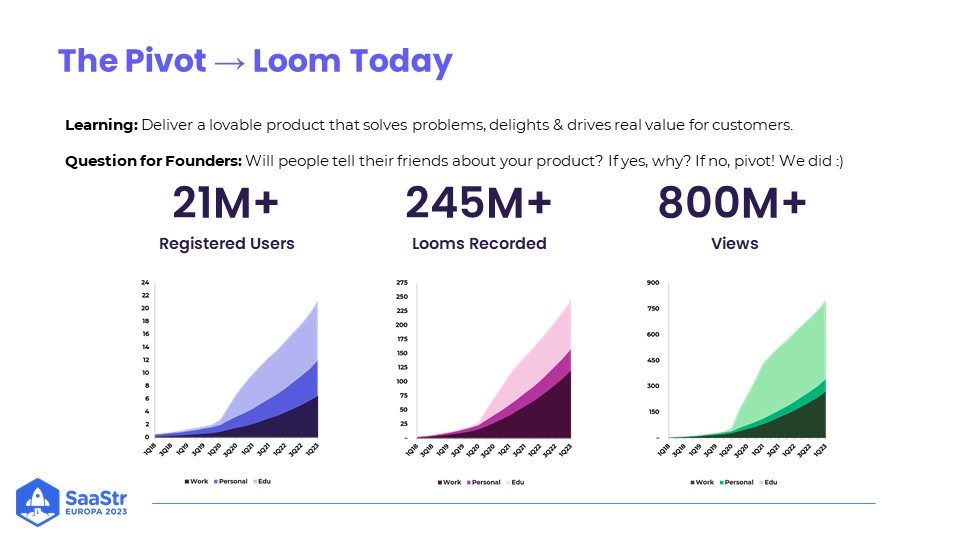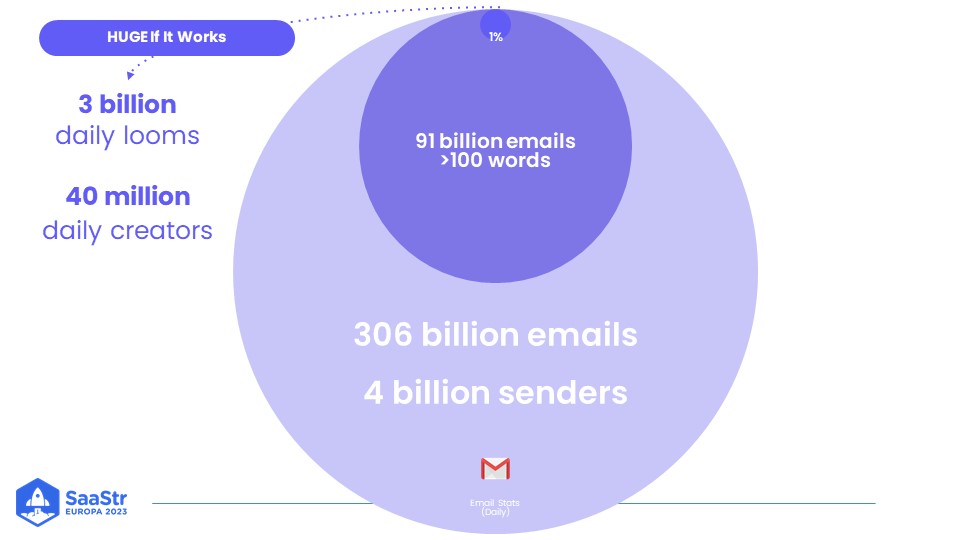With Loom announcing its almost $1B acquisition by Atlassian, we thought it would be a great time to dig back on CEO Joe Thomas’s presentation at SaaStr Europa in June on how they got there.
Joe Thomas, CEO & Co-founder of Loom, shared 5 hard-earned lessons on the way from two weeks of runway to a $1.5B valuation.
Lesson #1: Think Hard About Whether There Is Exponential Growth In Market
Arguably, the most important thing to consider when starting a company and a product is exponential growth in market.
Thomas wishes they understood this as first-time founders, but it wasn’t the case.
When they finally pivoted to the product they’re working on today and the products they were building before Loom, they showed up with a whiteboard, and each of the three co-founders brought three ideas to the table.
The idea they chose: To bring video to the workplace.
Video was everywhere in the consumer marketplace, but at work, people were still communicating through Outlook, and Slack was new on the scene. Video was nowhere to be found.
The Loom team says they weren’t cool enough to build consumer products, especially up against the likes of Instagram and Youtube, which were growing exponentially at the time. But they could bring some of that behavior to the workplace.
The Lesson — If you’re starting a company or in the early stages of building a company, think hard about whether there is exponential growth in the market you’re going after. It’s much easier to ride a wave than create one yourself.

Lesson #2: You Need To Make A Product So Good That People Tell Their Friends About It
If you’re trying to build a venture-backed company, it’s critical to make a product so good that people tell their friends about it.
Of course, this is much easier said than done, but so worth the effort to make it happen.
The Loom co-founders built a product called OpenTest, a two-sided marketplace that partially flopped after launch. There was a video-building layer in the middle of the product, though, that garnered interest.
Even though OpenTest didn’t take off, putting a product in the market created a rich ecosystem to receive feedback and provided them with those golden nuggets that eventually became the makings of Loom.
In June of 2016, the beginnings of Loom, called OpenVid, became the number one Product Hunt that day, and the following day, they launched more videos than the day before.
They had made it. People were sharing it on Twitter, and once people told their friends about it, it compounded on top of itself over the course of time.
The Takeaway — If you can think really, really hard and hit that bar that’s incredibly hard to hit, it’ll compound on itself over time.

Lesson #3: Once You’ve Found Your Kernel of Truth, You Have To Build An Ambitious Vision Around It
They’d done it. They’d pulled on the right strings to make a viral product, but they didn’t know what they did to achieve it.
You have to figure that out, that kernel of truth or earned secret, and then build an ambitious vision around it.
If you can figure out how to build a definite view of the future, it can be huge if it works.
Loom wasn’t the first entrant on video messaging at work, so if they wanted to unlock the potential of the industry, they had to go big, owning every step of the journey of recording, editing, storing, etc.
The broader landscape wasn’t going for the holistic end-to-end opportunity, so they found their in.
After receiving millions of no’s for a long time, they finally got a yes after sharing a more ambitious vision.
For example, the most ubiquitous messaging platform is email. If you took the daily emails sent and shrunk that down to long-form emails (because looms are 2-3 minutes on average) only. And then you capture only 1% of that long-form messaging opportunity. You end up with 3B daily looms and 40M daily creators.
The Takeaway — Once you make something clear and tangible, it becomes much more valuable. You have to have a clear and ambitious vision once you know the kernel of truth that you’re building against.

Lesson #4: You Need To Know How You’ll Grow
Beyond Loom’s Product Hunt launch, they didn’t know how they would grow. They were throwing things over the fence, hoping they’d work.
Loom needed more principles on how they’d distribute and grow.
What are the key steps to growth? Loom used the flywheel concept to figure that out. Read more about it here.
Loom ended up mapping out critical steps for growth because they knew they had an inherently viral product.
At the end of the day, their job was to figure out how to enable more people to record and share with one another. From there, growth would naturally happen.
Your distribution strategy may be leaning into the viral nature of your product, but ultimately, if you’re in the early stages, you truly only have time for one channel that directly aligns with your company as much as possible.
The Takeaway — Be honest with yourself. Many startups try to do too many things in the early days. The more you can perfect your one thing, the greater your chances of unlocking the most growth over time. You can add more channels later.

Lesson #5: Startups Win Because Of Momentum and a Team Mindset
In the beginning, you want a group of founders who will do whatever it takes to build something great and not stop. As you grow, you build a team that adopts that mindset, growing the company culture alongside the business.
As a startup, you only need one yes compared to a major corporation that likely needs a lot of yeses all the way up the ladder.
And then your team mindset and cultural values end up being unbelievably important. You can iterate and evolve those values over time, but ideally, their core will remain.
With the mindset of “together, we can,” your company can go far. Everyone is invested in building momentum because, in the early days, everyone is essentially an owner.
The Takeaway — As a startup employee or founder, you need to be optimistic, to have a screw loose, because it’s harder in nature and much more valuable. A bias for action, a group of people who want to get stuff done in a way aligned with the cultural values, will keep you accelerating.

Key Takeaways
Loom’s co-founder, Joe Thomas, says this framework for building a startup is really about thinking hard about what it means to build a successful company. It’ll be different for every startup.
The key lessons were:
- Determine if there is exponential growth in market.
- Build a product so good people tell their friends about it.
- Create an ambitious vision around your kernel of truth.
- Figure out how you’re going to grow.
- Team mindset and momentum are critical components for building a successful startup.

